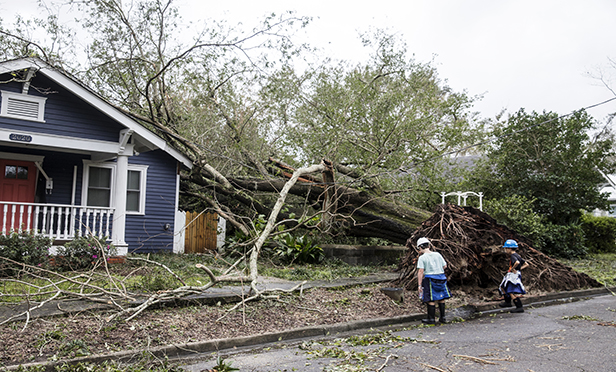 Children look at a fallen tree lying on a damaged home after Hurricane Florence hit in Wilmington, N.C., on Sept. 16, 2018. (Photographer: Alex Wroblewski/Bloomberg)
Children look at a fallen tree lying on a damaged home after Hurricane Florence hit in Wilmington, N.C., on Sept. 16, 2018. (Photographer: Alex Wroblewski/Bloomberg)
As the cleanup from Hurricane Florence and its aftermath continues, homeowners will be trying to make sense of their insurance coverage. And even though the Atlantic Basin is currently quiet, hurricane season runs through Nov. 30, so the Eastern U.S. isn’t completely out of danger. Just to make things more complicated for South Carolina residents, the Waccamaw River, which spans both states, is expected to flood through the weekend.
Deductibles are just one component of homeowners policies that cause some confusion. Here is an overview of what agents and brokers need to understand about hurricane deductibles — and information to share with clients.
A standard homeowners policy covers damage from wind, but damage from hurricane strength winds is a different matter. It can cause severe damage to property, even demolishing buildings.
Related: Predicting the impact of Florence: What insurance agents can expect
Several states in hurricane-prone areas have developed specific deductibles that apply in the event of such storms. Many endorsements use watches and warnings from the National Hurricane Center (NHC) or the National Weather Service (NWS) as the trigger for use of the deductibles. Both agencies are part of the National Oceanic and Atmospheric Administration (NOAA).
Deductibles are often available as a dollar amount or a percentage. Generally, when purchasing homeowners coverage, the insureds select the deductible they’re comfortable with and it’s then scheduled onto the endorsement.
Related: How to calculate deductibles for multiple related losses
Calendar-year deductibles — only in Florida
Florida is the only state with calendar-year deductibles, which are applicable to all losses that occur in one calendar year. If the policy spans more than one year, then two separate calendar-year deductibles are used.
Example: A Florida homeowners policy is effective from June 1, 2017, to June 1, 2018. The calendar-year deductible is $5,000. In August 2017, the insured sustained a hurricane loss and the $5,000 deductible was applied. In June 2018, the insured sustained another hurricane loss. Because this is a different year, even though it’s the same policy period, another $5,000 hurricane deductible is applied.
Deductibles by state
The following chart shows the states with hurricane deductibles, the dollar amount and percentage of the deductibles, and when the deductible is in effect or is applied. All endorsements refer to ISO Homeowners Policy Forms.
To use this chart, check the form number of the endorsement and the state in which the property is located. Then, see which dollar amount or percentage applies to your client’s policy. Finally, check the NWS for the dates and times that they issued the applicable hurricane watch or warning.
There is no specific endorsement for North Carolina, only South Carolina, which may be good or bad news, depending on your situation. The following chart shows the deductibles for South Carolina.
| Endorsement | Dollar amount of deductible | Percentage deductible | When the deductible is in effect or applied |
| HO 03 61 South Carolina | $1,000 $2,000 $5,000 $7,500 $10,000 |
1% 2% 5% 7.5% 10% |
Begins when a hurricane watch or warning is issued by the NHC. Ends 24 hours after termination of last watch or warning. |
The full chart showing additional states that have specific endorsements is available in this PDF.
Related: Hurricane Florence insured losses estimated to hit $2.5B















 Copyright © 2024 ALM Global, LLC. All Rights Reserved.
Copyright © 2024 ALM Global, LLC. All Rights Reserved.